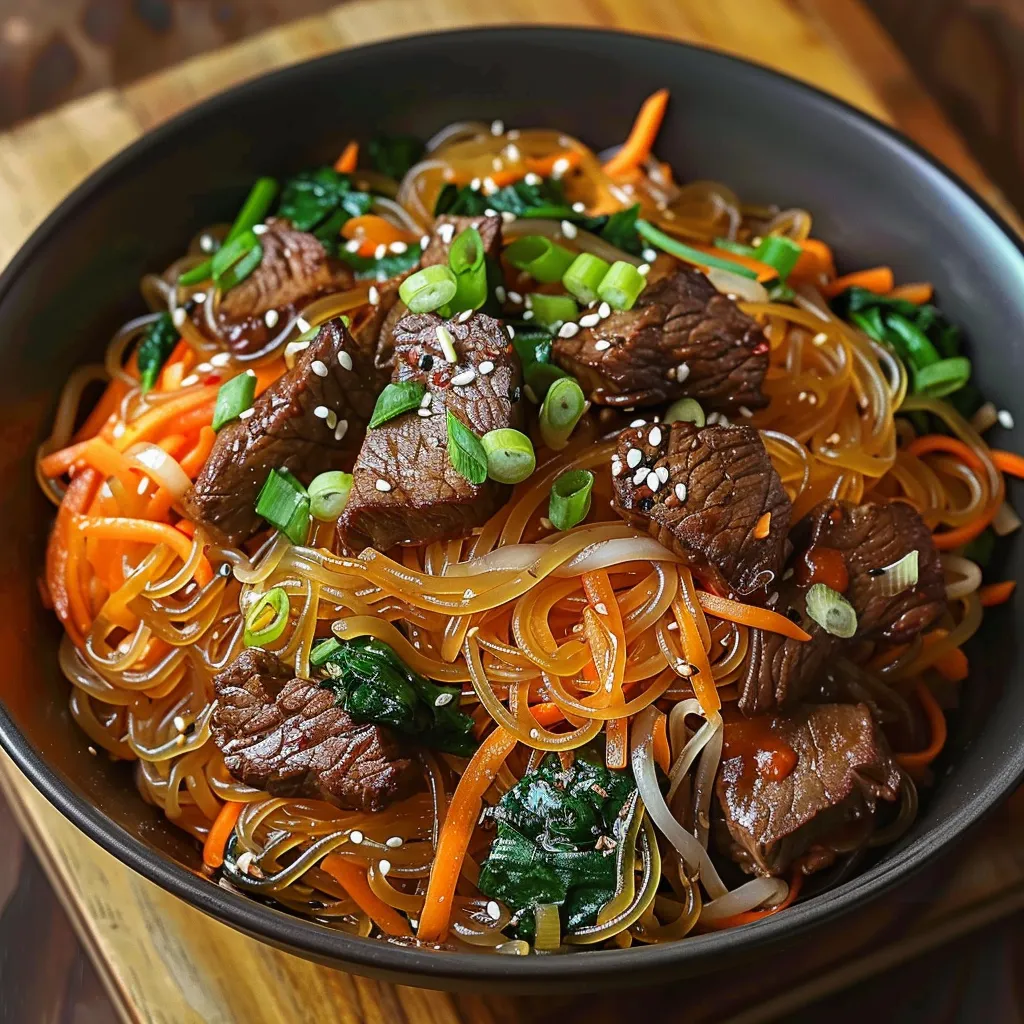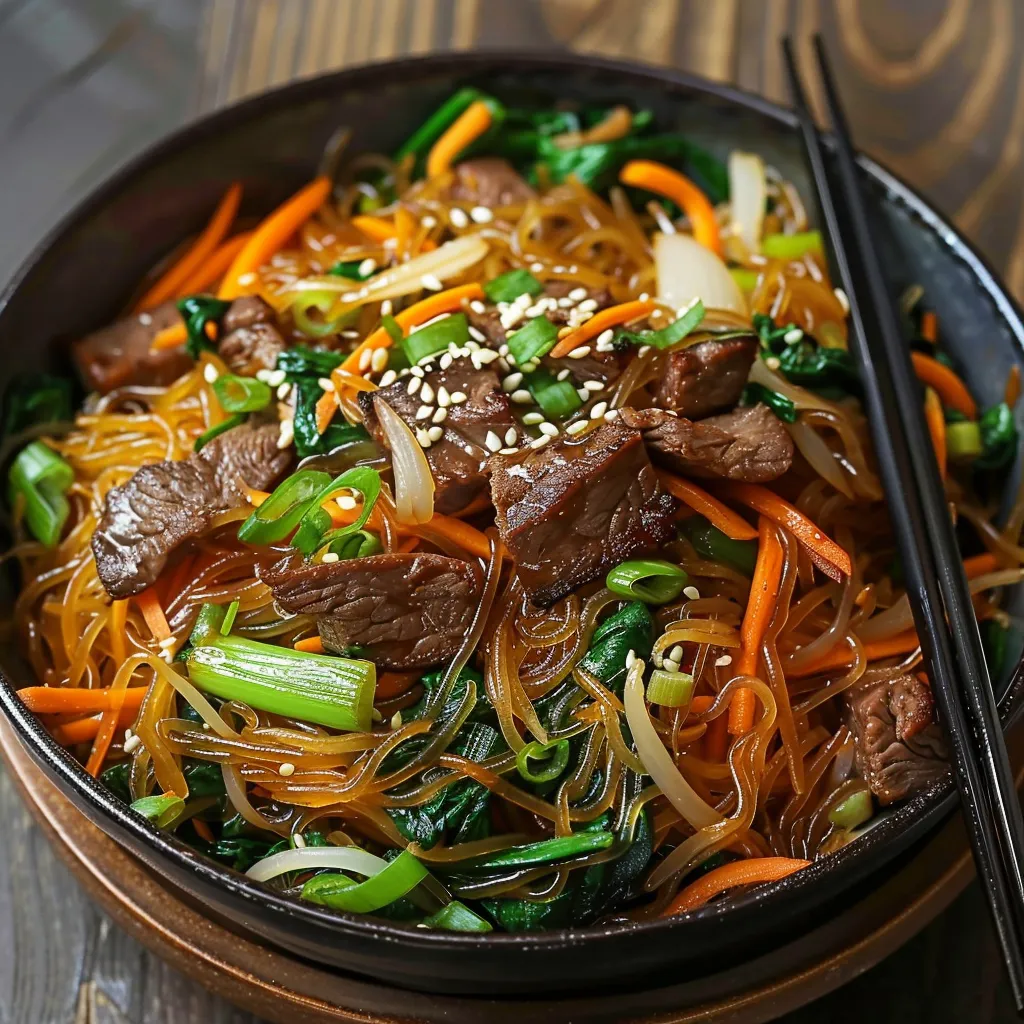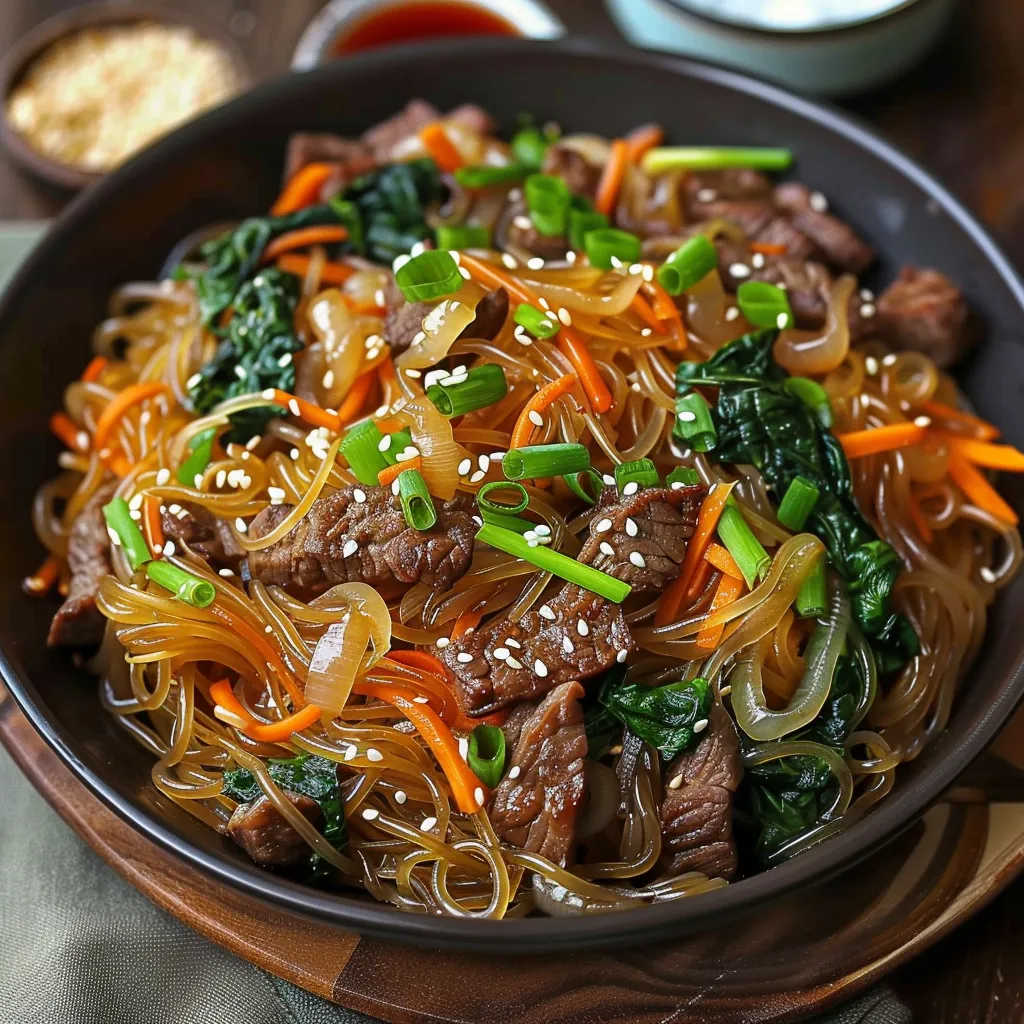 Pin to Favorites
Pin to Favorites
The first time I tasted japchae at a Korean friend's home, I was captivated by the unique texture of the glistening, slightly sweet noodles and the colorful medley of vegetables and beef. This beloved dish has become my go-to for potlucks and family gatherings, where it never fails to draw curious questions and delighted expressions after the first bite.
Essential Ingredients and Selection Tips
- Korean Sweet Potato Noodles (Dangmyeon): These translucent noodles provide the signature chewy texture. Available at Korean or Asian grocery stores, they are essential to authentic japchae.
- Thinly Sliced Beef: Ribeye or sirloin works best. For convenience, many Asian markets sell pre-sliced beef for bulgogi.
- Fresh Vegetables: Carrots for sweetness and crunch, spinach for earthiness, onions for depth, and green onions for a fresh contrast.
- Sesame Oil: A key flavor component; look for toasted sesame oil with a deep amber color and nutty aroma.
- Soy Sauce: A high-quality, naturally brewed Korean or Japanese soy sauce enhances the umami flavor.
 Pin to Favorites
Pin to Favorites
Detailed Cooking Instructions
- Preparing the Noodles
- Bring a large pot of water to a rolling boil. Add a tablespoon of olive oil to prevent sticking. Boil 1 pound of sweet potato noodles for 5-6 minutes, stirring occasionally. Drain and rinse under cold running water. Toss with 1 tablespoon of sesame oil to prevent clumping.
- Marinating and Cooking the Beef
- In a medium bowl, combine 2 pounds of thinly sliced beef with 3 tablespoons of soy sauce, 1 tablespoon of sesame oil, and 1½ tablespoons of brown sugar. Marinate while prepping vegetables. Heat a large skillet over high heat, then cook the beef in batches for 2-3 minutes until just cooked through. Set aside with juices.
- Cooking the Vegetables
- Wipe the skillet clean and heat 1 tablespoon of olive oil. Stir-fry 1 julienned carrot and 1 sliced onion for 3-4 minutes. Add 6 minced garlic cloves and cook for 30 seconds. Stir in 3 tablespoons of soy sauce, 2 tablespoons of sesame oil, and 1½ tablespoons of brown sugar. Finally, add 3 sliced green onions and stir for another minute.
- Cooking the Spinach
- Add ½ pound of fresh spinach to the skillet, stirring until just wilted, about 30-45 seconds. Remove from heat immediately to maintain texture.
- Combining Everything
- In a large bowl, toss together the cooked noodles, beef, and vegetables. Use tongs to gently combine. If needed, drizzle an additional tablespoon of sesame oil for moisture. Taste and adjust seasoning. Garnish with toasted sesame seeds before serving.
The Joy of Adaptations
- Mushroom Variation: Add shiitake or oyster mushrooms for extra depth.
- Vegetarian Option: Replace beef with extra mushrooms or pan-fried tofu.
- Lower Carb: Reduce noodles and double the vegetables.
- Summer Japchae: Serve chilled over crisp lettuce for a refreshing dish.
You Must Know
- Don't overcook the noodles—they should remain chewy.
- Cook vegetables separately to maintain texture and vibrant color.
- The dish improves in flavor after resting, making it ideal for meal prep.
- Noodles absorb sauce over time—add a drizzle of sesame oil before serving leftovers.
Chef’s Essential Tips
- Perfectly chewy noodles: After rinsing, snip the noodles with kitchen shears into shorter, more manageable lengths.
- Flavor booster: Toss a tablespoon of the reserved beef juices with the noodles for extra depth.
- Uniform slicing: Cut all vegetables in similar shapes for even cooking and a balanced presentation.
- Make-ahead strategy: Prepare japchae a few hours before serving to allow flavors to meld. Toss with fresh sesame oil before serving.
Japchae is more than just a dish—it represents harmony in Korean cuisine, blending flavors and textures into something truly special. Whether you're making it for a celebration or a simple weeknight meal, this recipe brings together tradition and adaptability in every bite.
 Pin to Favorites
Pin to Favorites
Frequently Asked Questions
- → Where can I find Korean sweet potato noodles?
- Korean sweet potato noodles (dangmyeon) can be found in Asian grocery stores, international food sections of larger supermarkets, or online. They're sometimes labeled as glass noodles or cellophane noodles.
- → Can I make Japchae vegetarian?
- Yes, simply omit the meat and add more vegetables like mushrooms, bell peppers, or zucchini. You can also add tofu for protein.
- → How do I store leftover Japchae?
- Store in an airtight container in the refrigerator for up to 3-4 days. Reheat in a pan with a splash of water or briefly in the microwave.
- → Why are my sweet potato noodles too sticky?
- Rinse the noodles with cold water after cooking and toss with a little sesame oil to prevent sticking. Don't overcook them - they should be chewy, not mushy.
- → Can I make Japchae ahead of time?
- Yes, Japchae tastes great even after being refrigerated. Make it a day ahead and reheat gently for gatherings or meal prep.
